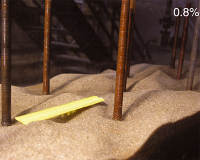Template:TEXT BOX LEFT: Difference between revisions
From CSDMS
No edit summary |
No edit summary |
||
| Line 1: | Line 1: | ||
[[ | [[Image:Rigidstemvegetation_frontpage.png|200px|left|link=Science_spotlights#Vegetation_Can_Increase_Bedload_Flux]] | ||
'''Vegetation Can Increase Bedload Transport'''<br>Vegetation in floodplains is often thought to be an efficient agent to alter flow and trap sediment. However, tank experiments show that bedload fluxes can actually be higher through vegetation patches due to increased near-bed high turbulence and scouring. A study presented in a recent issue of Journal of Geophysical Research suggests that bedload fluxes around vegetation can vary spatially by an order of magnitude and local scour zones and bedforms could negatively impact survival of nearby plants. [[Science_spotlights#Vegetation_Can_Increase_Bedload_Flux|More...]]<br><br>[mailto:csdmsweb@colorado.edu Nominate a science spotlight] | |||
Revision as of 17:15, 8 January 2014
Vegetation Can Increase Bedload Transport
Vegetation in floodplains is often thought to be an efficient agent to alter flow and trap sediment. However, tank experiments show that bedload fluxes can actually be higher through vegetation patches due to increased near-bed high turbulence and scouring. A study presented in a recent issue of Journal of Geophysical Research suggests that bedload fluxes around vegetation can vary spatially by an order of magnitude and local scour zones and bedforms could negatively impact survival of nearby plants. More...
Nominate a science spotlight

